A large team of the Fed’s researchers have been busy constructing a new database containing quarterly estimates of the distribution of US household wealth since 1989.
They launched it with the release of a March 2019 working paper titled “Introducing the Distributional Financial Accounts of the United States.”
The Distributional Financial Accounts (DFA) is an impressive accomplishment combining quarterly aggregate measures of household wealth from the Financial Accounts of the United States (FA) and triennial wealth distribution measures from the Survey of Consumer Finances (SCF). 
I. A much more comprehensive database
We believe that the new database can be used to resolve lots of controversial issues about wealth distribution in the US. The DFA’s balance sheet of the household sector is much more comprehensive and timely than previously existing sources. The Fed’s researchers observe that their “approach produces rich and reliable measures of the distribution of the Financial Accounts’ household-sector assets and liabilities for each quarter from 1989 to the present.”
The data can be used to study the distribution of wealth in America by wealth and income percentiles, education, age, generation, and race. Melissa and I intend to do just that in the coming months with the goal of assembling a comprehensive study tentatively titled “Income & Wealth in America: Myths & Realities.”
II. Who owns equities in America, according to FA?
Aggregate data are available in Table L.223 in the FA for corporate equities held by each of the major sectors in the accounts. Unlike the DFA, the household sector in the FA includes nonprofit organizations, and this sector’s data are calculated residually from the other accounts. Let’s review our findings:
(1) The supply side of equities. The total market value of equities held in the US during Q2-2020 was $52.0 trillion, with domestic issues totaling $43.5 trillion and foreign issues totaling $8.5 trillion (Fig. 1). Domestic issues included $33.5 trillion of nonfinancial issues and $10.0 trillion of financial issues and consisted of $37.2 trillion of publicly traded and $6.3 trillion of closely held equities (Fig. 2 and Fig. 3). 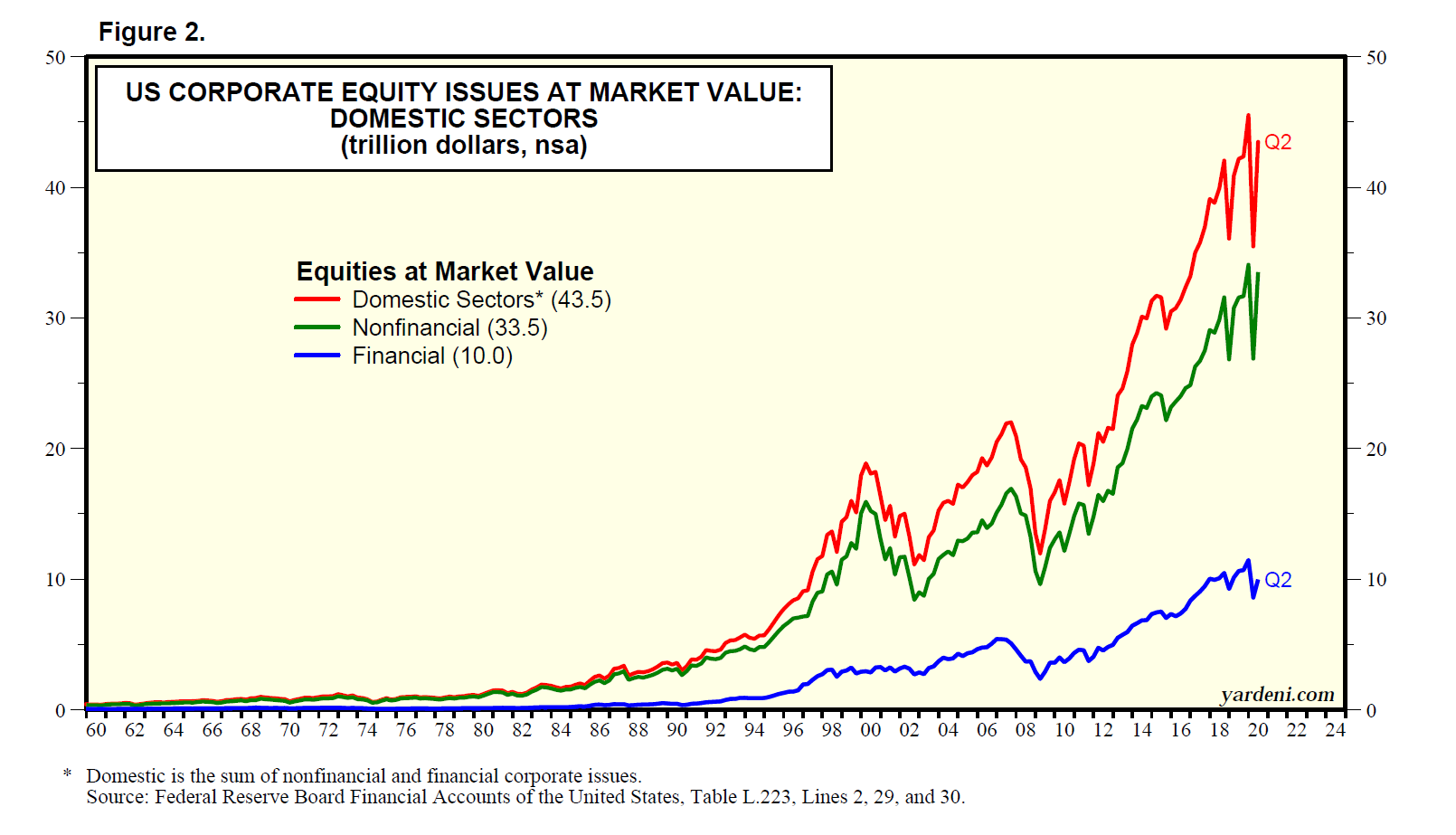
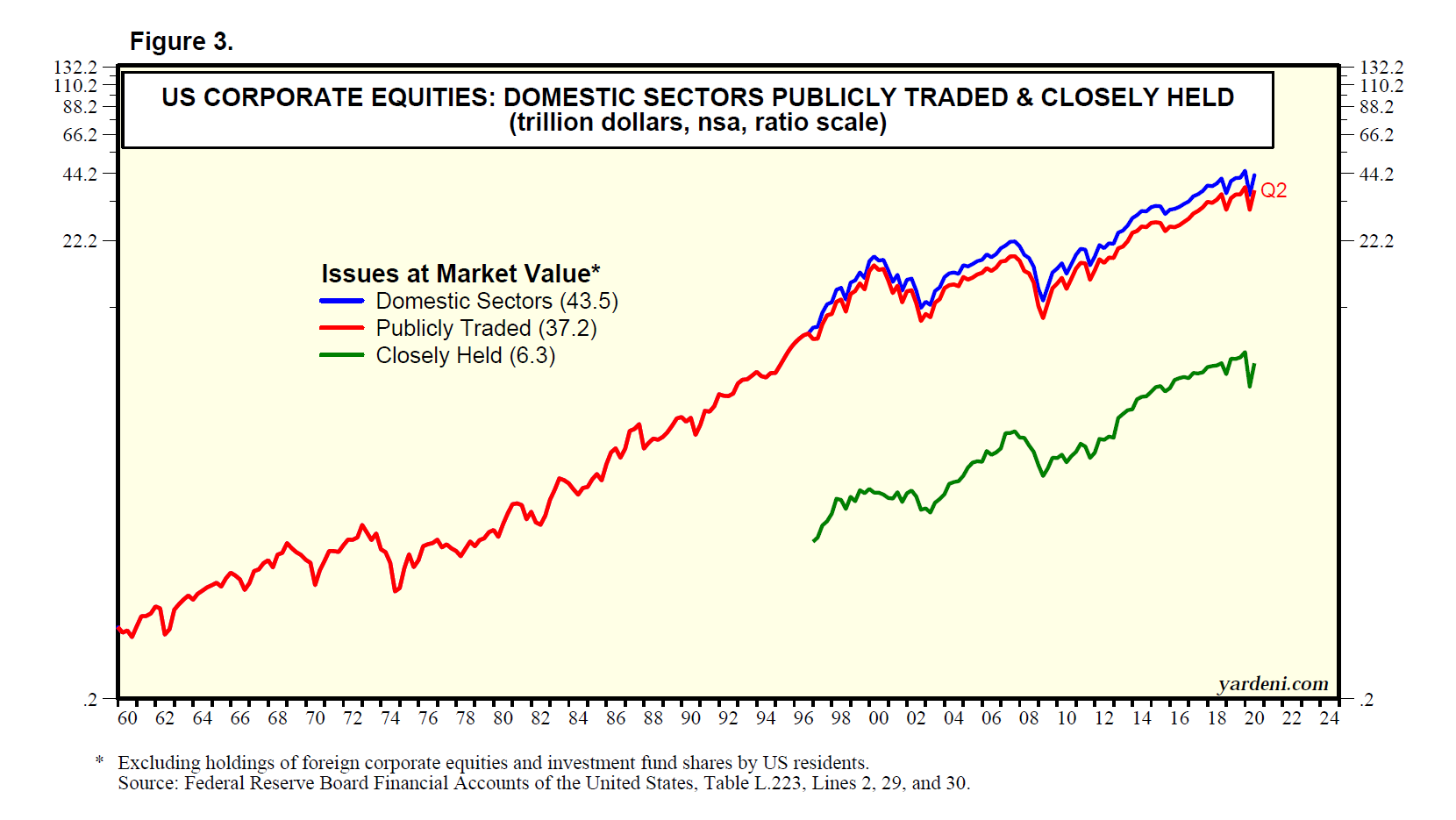 The $6.3 trillion of closely held equity consisted of $4.7 trillion in S corporations and $1.6 trillion in C corporations (Fig. 4).
The $6.3 trillion of closely held equity consisted of $4.7 trillion in S corporations and $1.6 trillion in C corporations (Fig. 4). 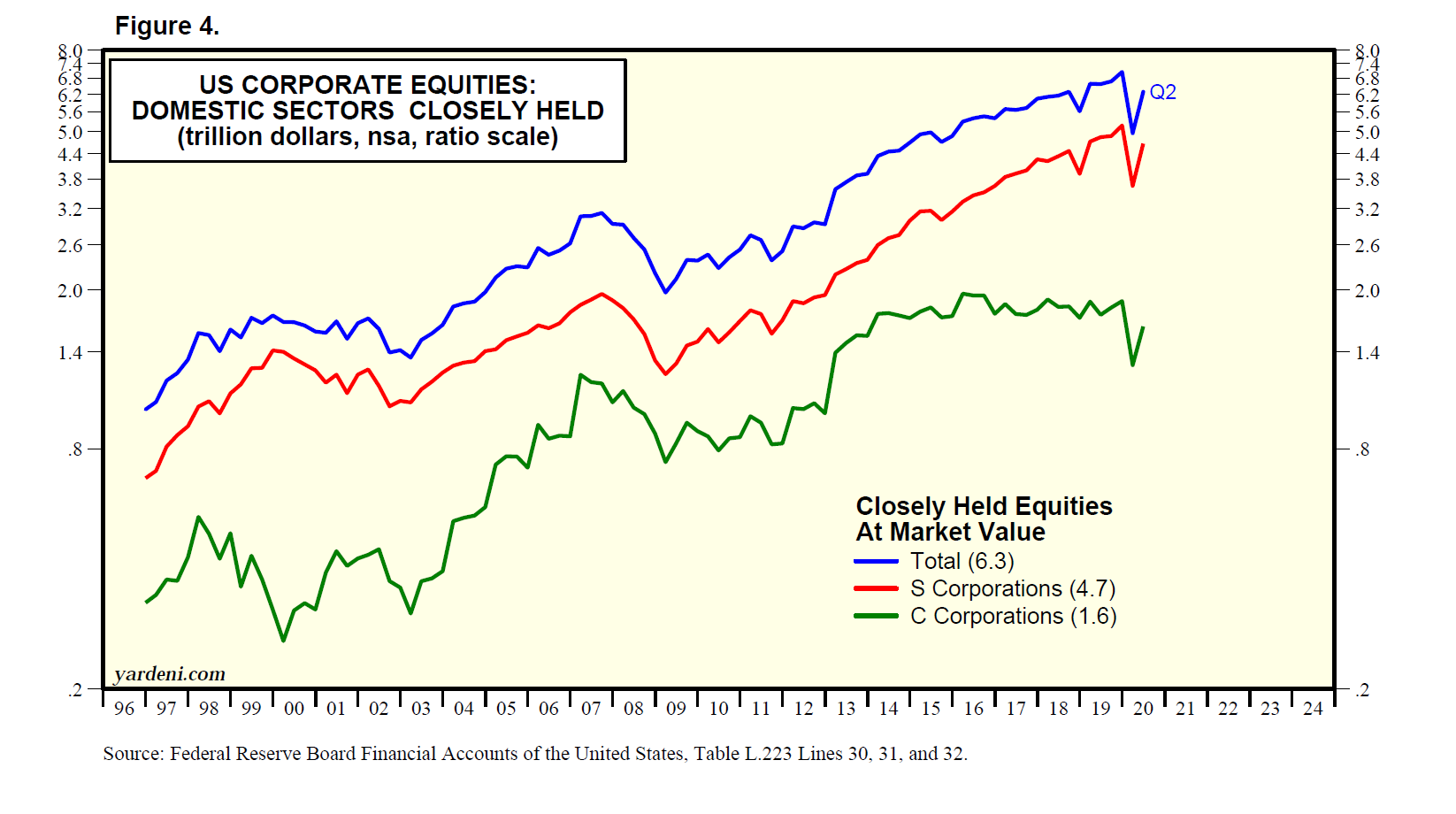 (2) Ownership by sectors. During Q2-2020, of the $52.0 trillion in equities, the major sectors directly held the following amounts and percentage shares: household sector ($19.5 trillion, 37.6%), mutual funds and exchange-traded funds (ETFs) ($14.5 trillion, 27.8%), rest of the world ($8.2 trillion, 15.8%), and institutional investors ($7.0 trillion, 13.4%) (Fig. 5 and Fig. 6).
(2) Ownership by sectors. During Q2-2020, of the $52.0 trillion in equities, the major sectors directly held the following amounts and percentage shares: household sector ($19.5 trillion, 37.6%), mutual funds and exchange-traded funds (ETFs) ($14.5 trillion, 27.8%), rest of the world ($8.2 trillion, 15.8%), and institutional investors ($7.0 trillion, 13.4%) (Fig. 5 and Fig. 6).
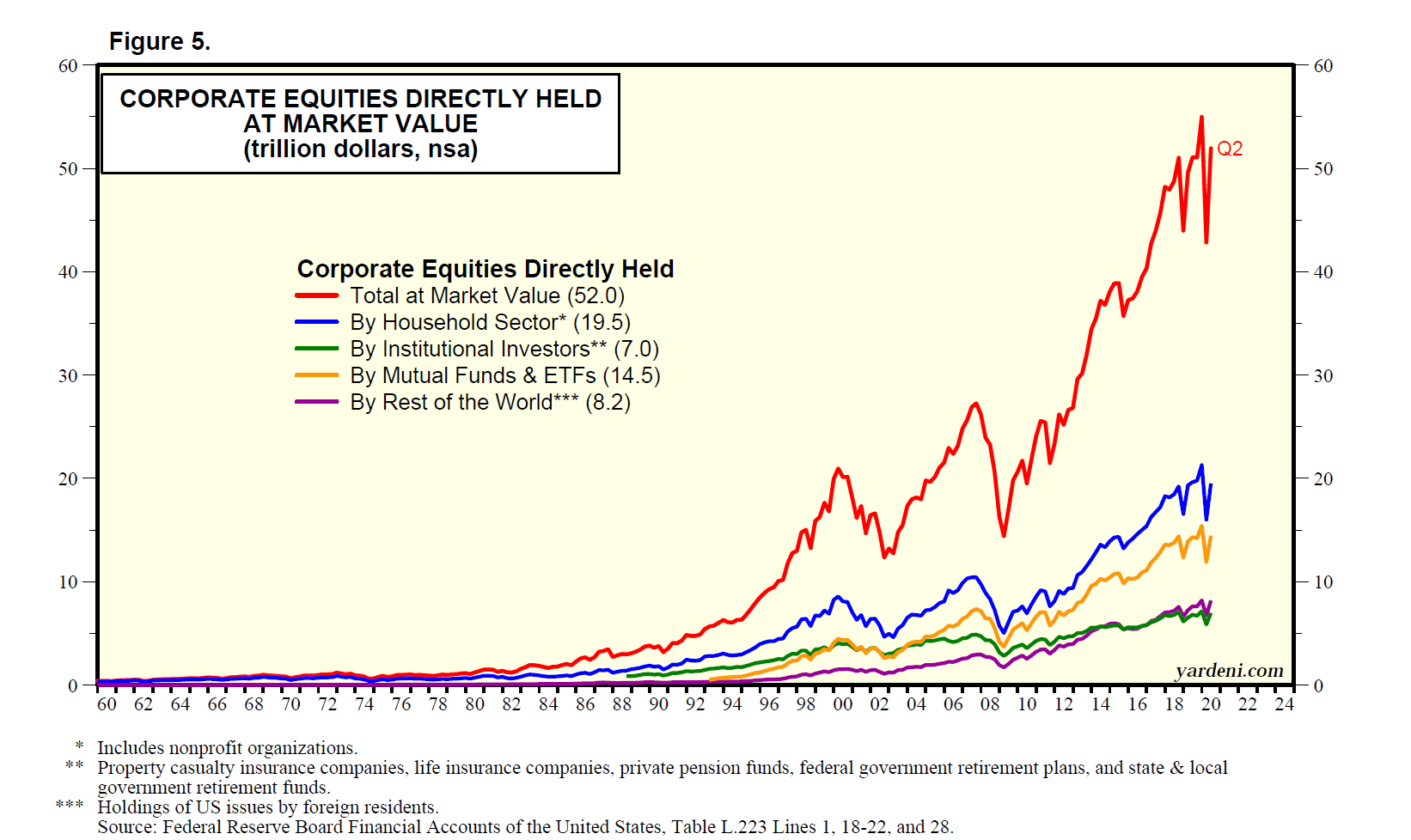
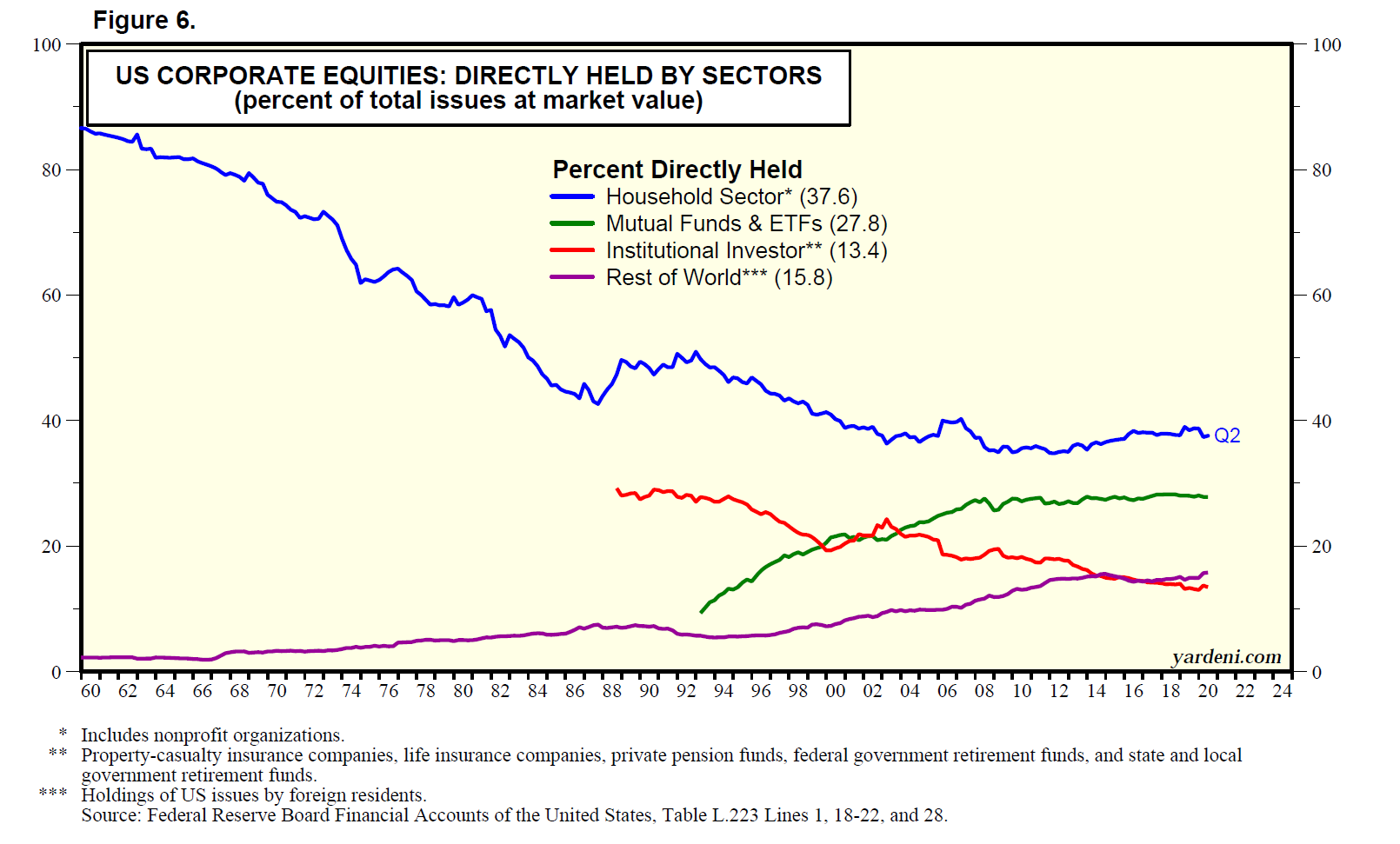 (3) Directly and indirectly held by households. The FA includes a Table B.101e titled “Balance Sheet of Households and Nonprofit Organizations with Debt and Equity Holdings Detail.” It provides extraordinary insight into the indirect equity holdings of households through life insurance companies, private and public pension funds, and mutual funds. During Q2-2020, households and nonprofits directly held $19.5 trillion (37.6% of all equities) and indirectly held $12.4 trillion (23.8% of the total) (Fig. 7).
(3) Directly and indirectly held by households. The FA includes a Table B.101e titled “Balance Sheet of Households and Nonprofit Organizations with Debt and Equity Holdings Detail.” It provides extraordinary insight into the indirect equity holdings of households through life insurance companies, private and public pension funds, and mutual funds. During Q2-2020, households and nonprofits directly held $19.5 trillion (37.6% of all equities) and indirectly held $12.4 trillion (23.8% of the total) (Fig. 7).
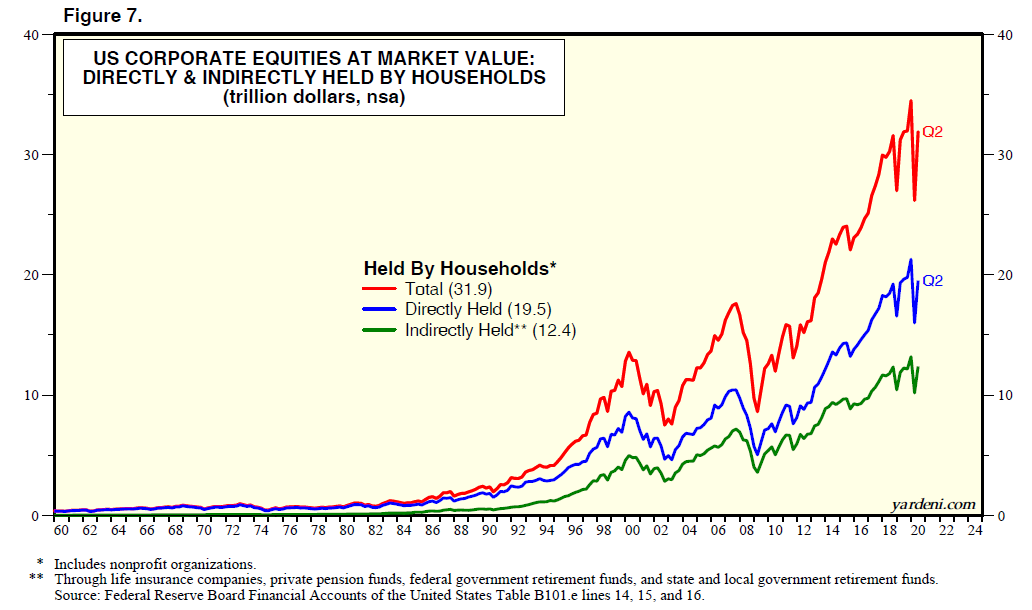 In other words, their direct and indirect holdings of equities totaled $31.9 trillion, or 61.4% of all equities (Fig. 8).
In other words, their direct and indirect holdings of equities totaled $31.9 trillion, or 61.4% of all equities (Fig. 8).
 Interestingly, this percentage has been remarkably stable around 65% since the early 1980s.
Interestingly, this percentage has been remarkably stable around 65% since the early 1980s.
III. Which households own equities, according to DFA?
The link between the household sector in the FA and in the DFA is Table B.101.h titled “Balance Sheet of Households,” which unlike Table L.223 excludes nonprofit organizations from the household sector. On the other hand, this balance sheet shows the household sector’s combined holdings of corporate equities and mutual fund shares, which include bond funds but not money market mutual funds or ETFs. The assets and liabilities in this version of the household balance sheet are the ones for which the DFA provides all the data needed for analyzing the distribution of household net worth. (See “Household Balance Sheet” from our forthcoming study on income and wealth in America.)
Now, let’s analyze the distribution of the DFA’s various series for corporate equites and mutual fund shares held by households, sliced and diced by wealth percentile, generation, and education:
(1) DFA by wealth percentiles. We repeat: The DFA is based on the FA’s Table B.101.h, which is the “Balance Sheet of Households” excluding the assets and liabilities of nonprofit organizations. It shows only annual data and reveals that corporate equities and mutual funds held by households at the end of 2019 totaled $29.1 trillion (Fig. 9).
 In the DFA, this series is shown on a quarterly basis. By the way, we can derive a similar quarterly series as the sum of corporate equities held by households and nonprofits plus mutual fund shares held by them, as reported in FA Table L.224, which excludes money market funds and ETFs (Fig. 10).
In the DFA, this series is shown on a quarterly basis. By the way, we can derive a similar quarterly series as the sum of corporate equities held by households and nonprofits plus mutual fund shares held by them, as reported in FA Table L.224, which excludes money market funds and ETFs (Fig. 10).
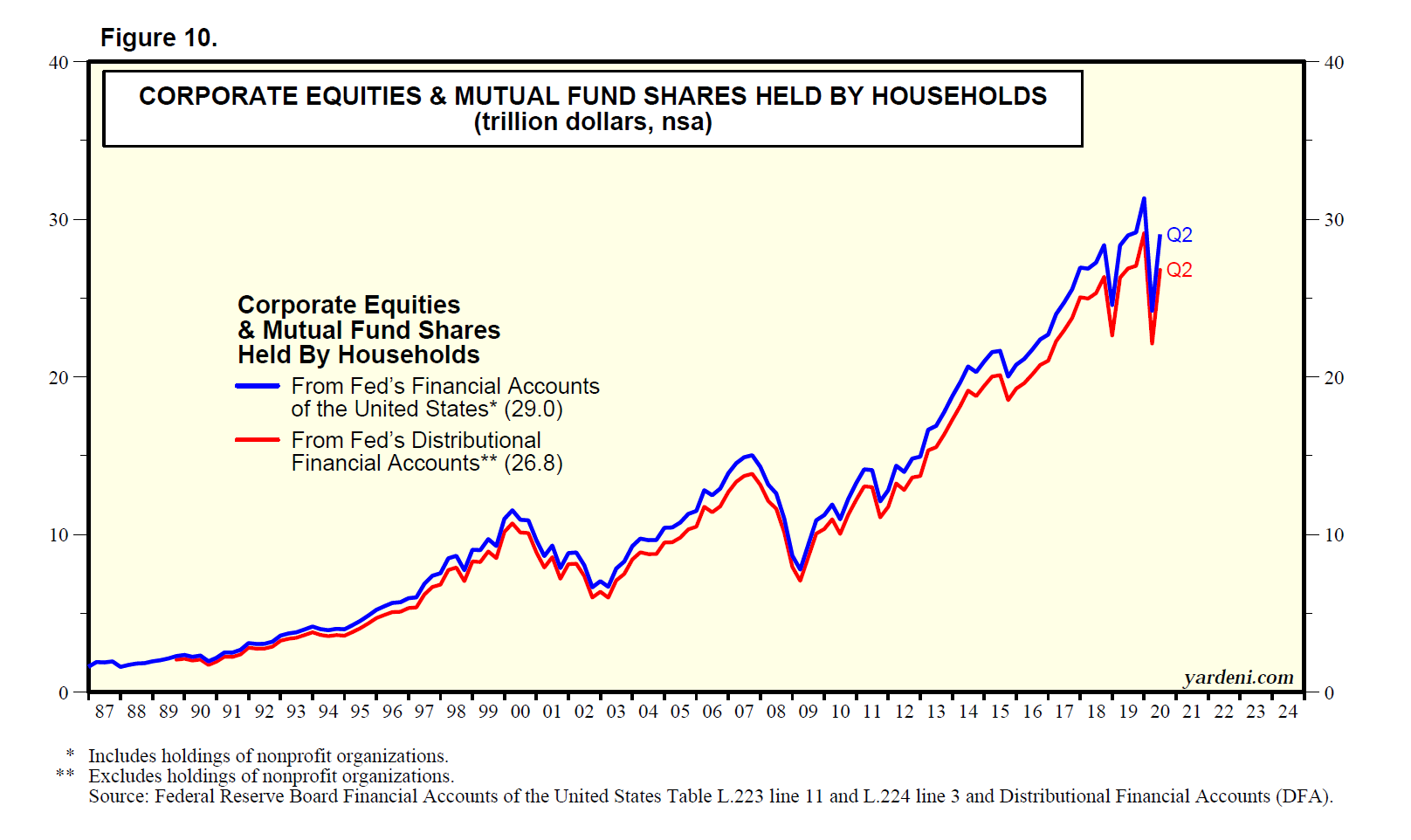 The DFA shows that corporate equities and mutual fund shares held by households was down slightly to $26.8 trillion during Q2-2020, with the following ownership and percentage shares of the total among wealth percentile groups: top 1% ($14.1 trillion, 52.4%), 90%-99% ($9.5 trillion, 35.8%), 50%-90% ($3.0 trillion, 11.2%), and bottom 50% ($0.2 trillion, 0.6%) (Fig. 11 and Fig. 12).
The DFA shows that corporate equities and mutual fund shares held by households was down slightly to $26.8 trillion during Q2-2020, with the following ownership and percentage shares of the total among wealth percentile groups: top 1% ($14.1 trillion, 52.4%), 90%-99% ($9.5 trillion, 35.8%), 50%-90% ($3.0 trillion, 11.2%), and bottom 50% ($0.2 trillion, 0.6%) (Fig. 11 and Fig. 12).
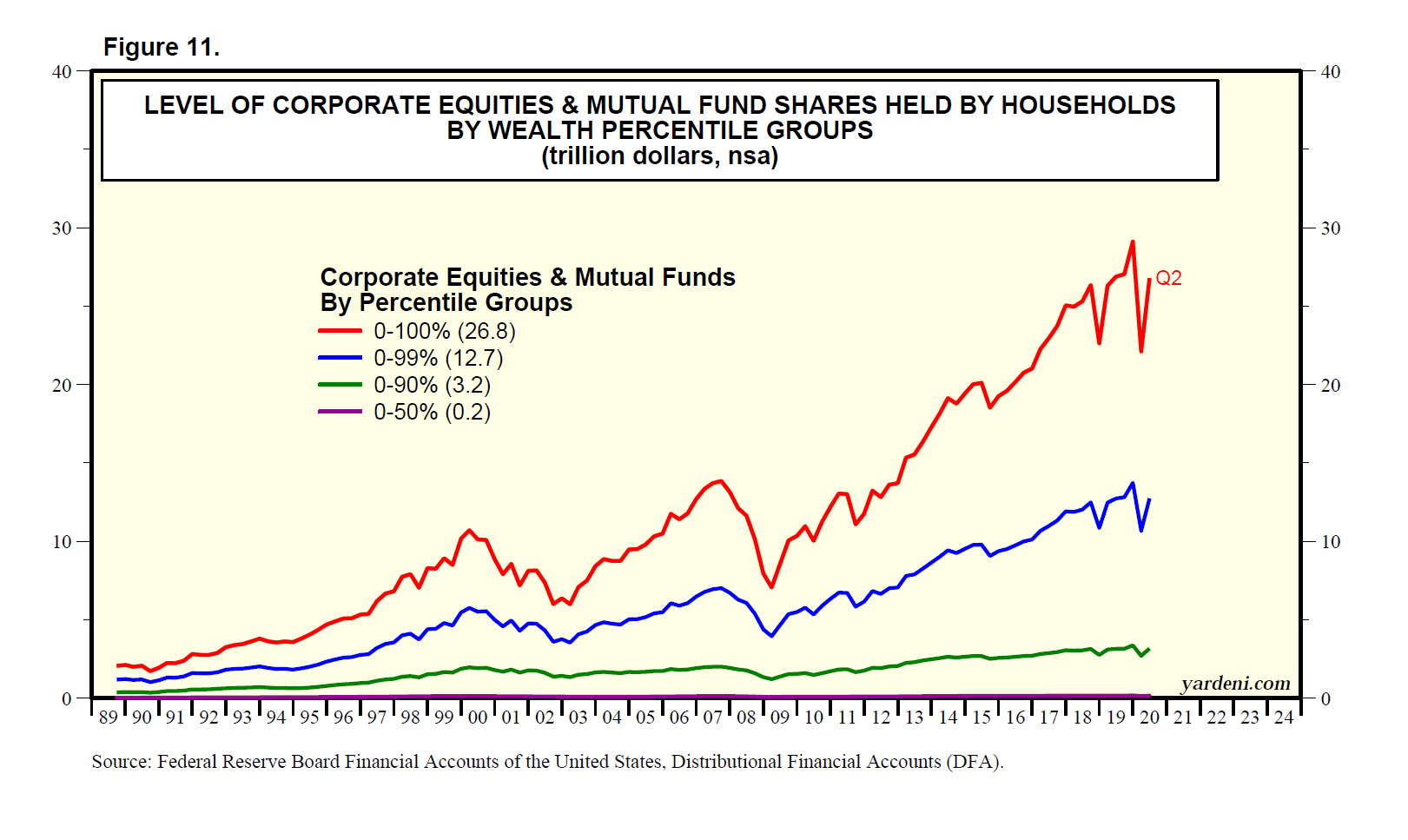
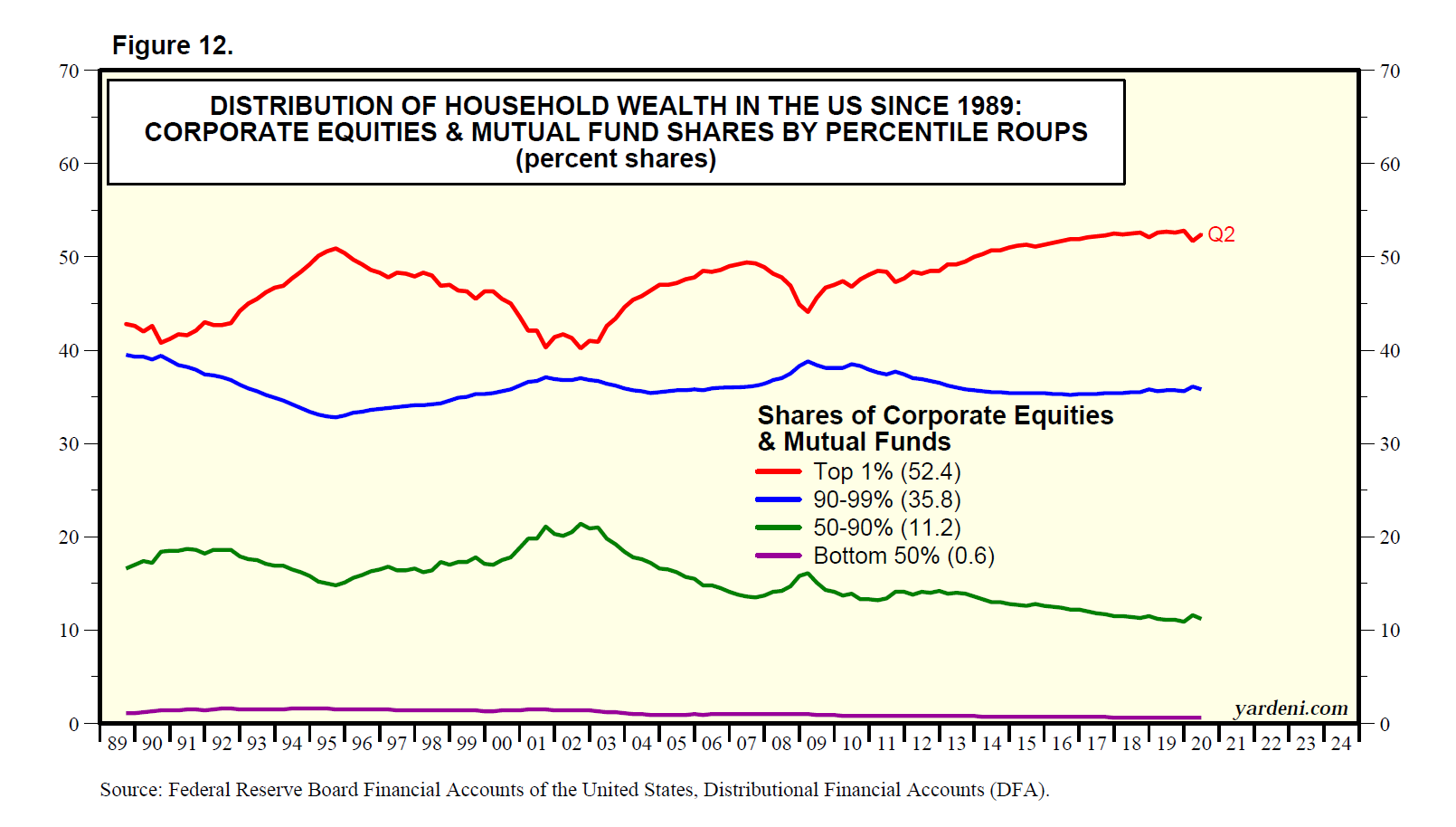 The bottom 50% never owned more than 1.6% of this asset category. The 50%-90% crowd’s share peaked at 21.4% during Q3-2002 and since has fallen to 11.2% currently. The 90%-99% group has held a fairly steady share around 35% since the early 1990s. The top 1% has ranged between a low of 40.2% and a high of 52.8%.
The bottom 50% never owned more than 1.6% of this asset category. The 50%-90% crowd’s share peaked at 21.4% during Q3-2002 and since has fallen to 11.2% currently. The 90%-99% group has held a fairly steady share around 35% since the early 1990s. The top 1% has ranged between a low of 40.2% and a high of 52.8%.
The widespread notion that the very rich own a disproportionate share of corporate equities is true, but their collective share is more like 50% of the total held by households than the urban legend of 80%-90%.
(2) DFA by generations. The DFA allows us to compare the amount of an asset or liability held and the percentage shares by four generations: Silent (born before 1946), Baby Boomer (1946-1964), GenX (1965-1980), and Millennial (1981-96).
Here are the values of corporate equities and mutual funds held by the four generations and their percentage shares during Q2-2020: Silent ($5.1 trillion, 19.0%), Baby Boomer ($14.8 trillion, 55.3%), GenX ($6.3 trillion, 23.4%), and Millennial ($0.6 trillion, 2.2%) (Fig. 13 and Fig. 14).
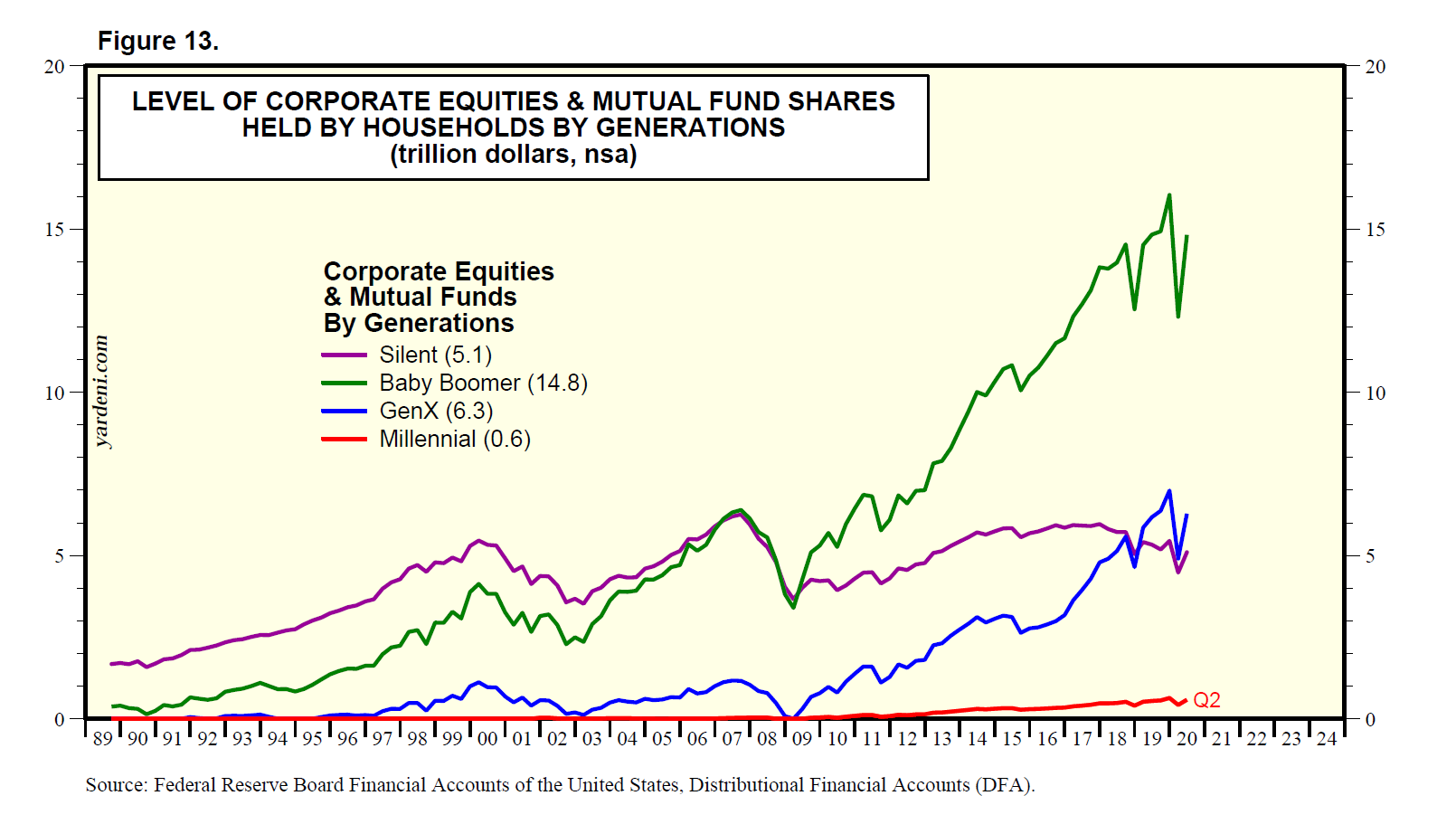
 Since the start of the data in 1989, the percentage share held by the Silent generation has dropped from around 80%-90% to 19% currently, while the percentage share of the Baby Boom generation increased from 10%-20% to 55% currently. The GenX share was close to zero in early 2009 and has been trending up; it’s around 23% currently. The Millennials’ share remains close to zero.
Since the start of the data in 1989, the percentage share held by the Silent generation has dropped from around 80%-90% to 19% currently, while the percentage share of the Baby Boom generation increased from 10%-20% to 55% currently. The GenX share was close to zero in early 2009 and has been trending up; it’s around 23% currently. The Millennials’ share remains close to zero.
(3) DFA by education. Finally for now, let’s have a look at the impact of education on the ownership of corporate equities and mutual fund shares. The DFA data show that households headed by college-educated persons held 82.9% of corporate equities and mutual fund shares during Q2-2020 (Fig. 15 and Fig. 16).
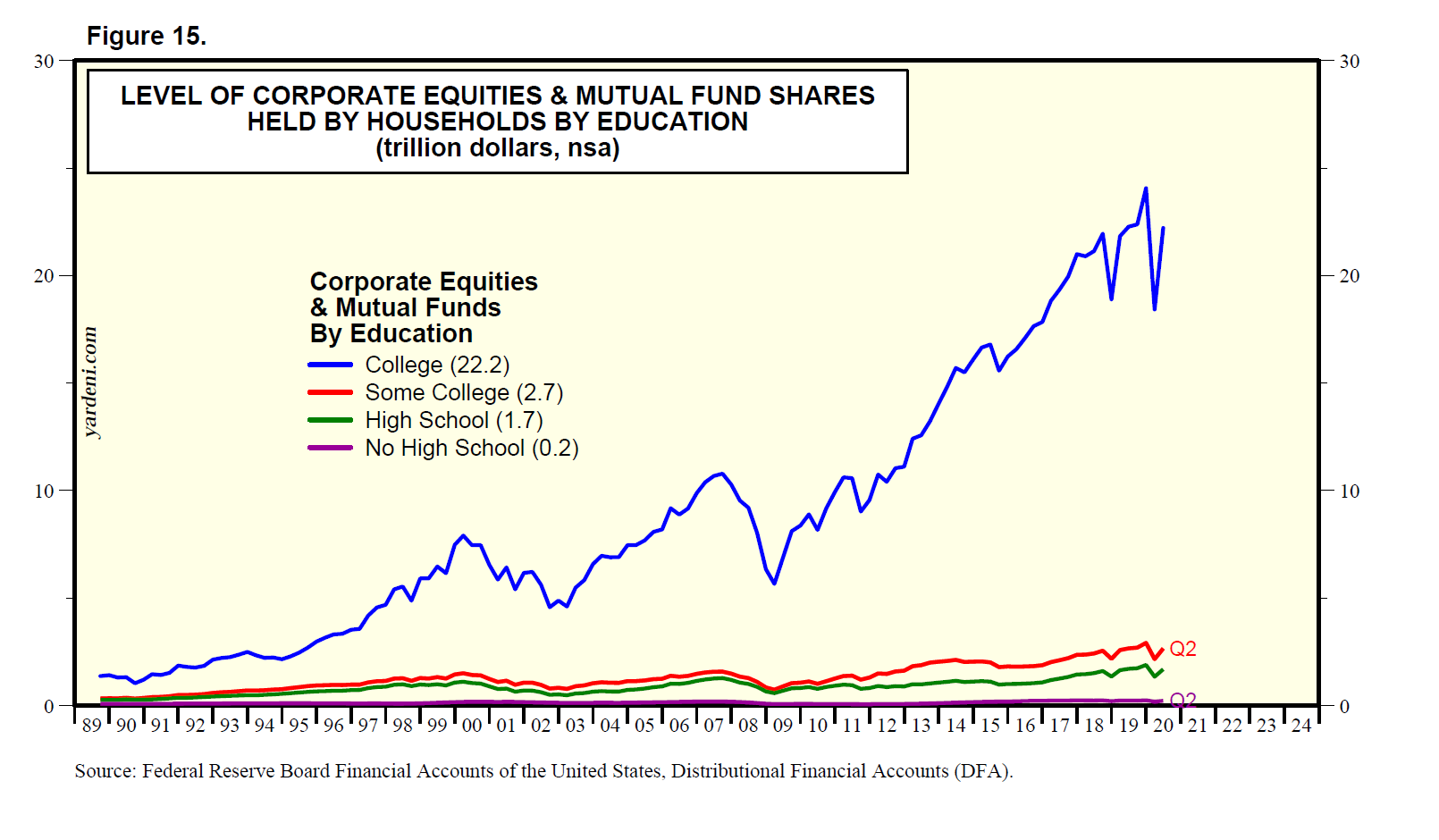
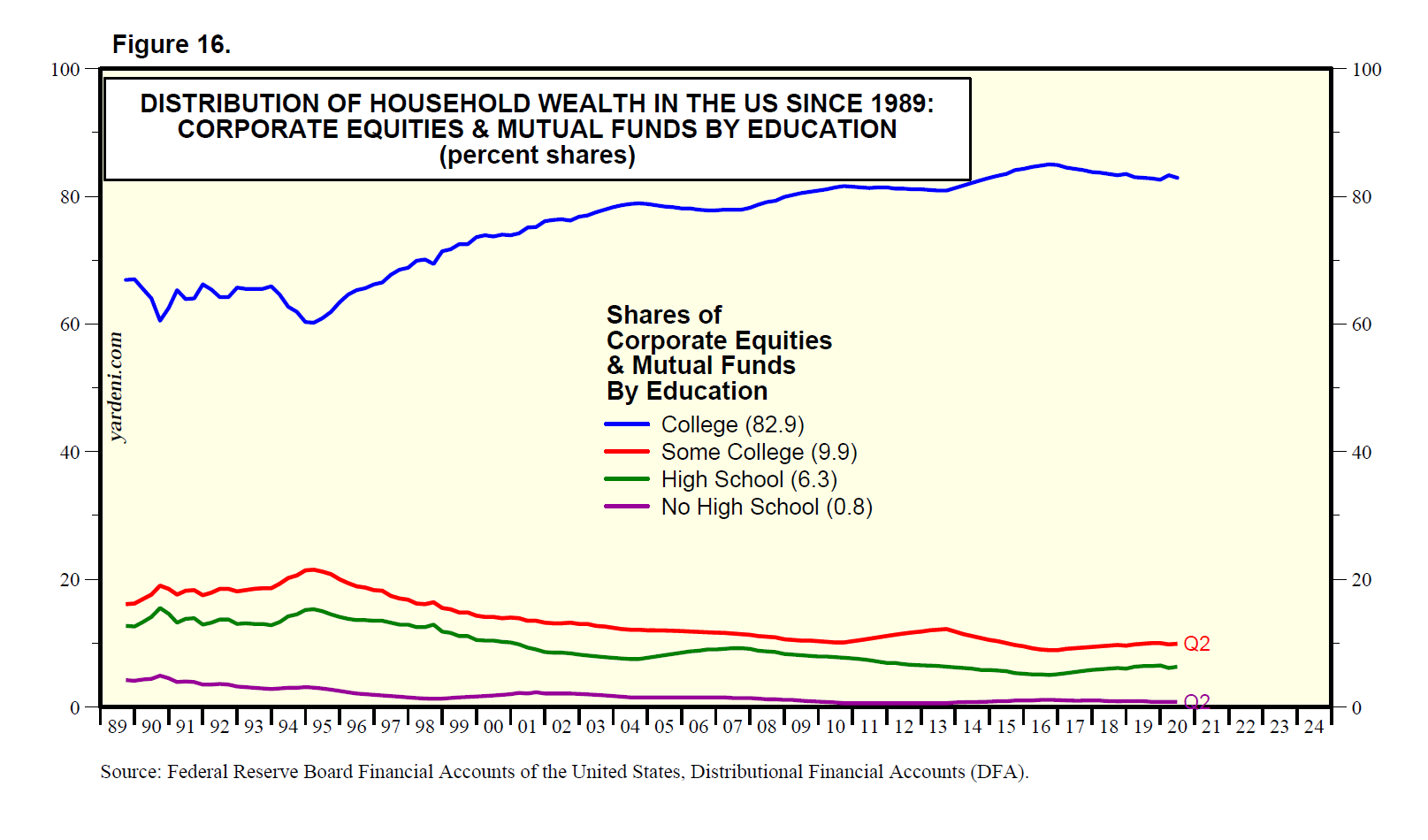 That percentage has been trending higher since Q1-1995, when it fell to a series low of 60.2%. Households with heads who had some college, high school, and no high school-owned only 9.9%, 6.3%, and 0.8%. Education is clearly a vitally important determinant of financial well-being.
That percentage has been trending higher since Q1-1995, when it fell to a series low of 60.2%. Households with heads who had some college, high school, and no high school-owned only 9.9%, 6.3%, and 0.8%. Education is clearly a vitally important determinant of financial well-being.
IV. What's the bottom line?
Since the early 1960s, the household sector (including nonprofit organizations) has directly and indirectly held 65% of equities in America. Of the equities held by households (excluding nonprofit organizations), the “1%” hold around 50% of this asset class. Older people with college educations tend to own more equities than younger ones with less education.
